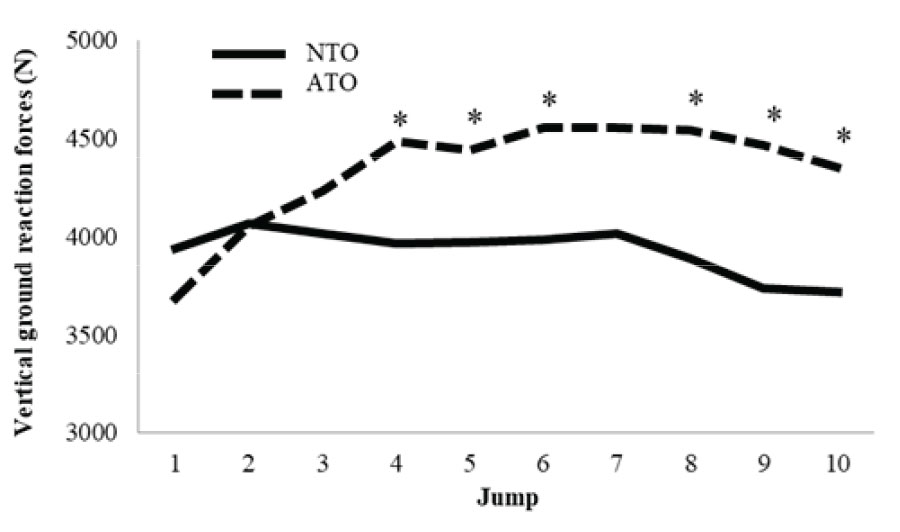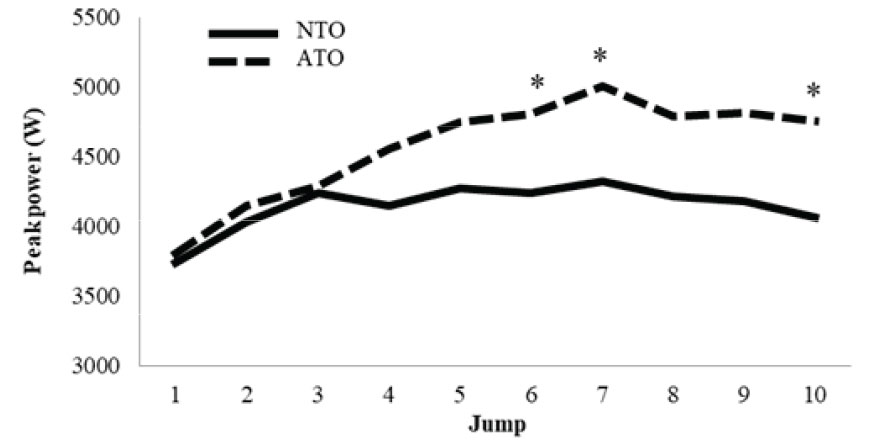Acute influence of loaded jump squat technique on kinetic variables in track and field athletes
ˑ:
PhD, Hubert Makaruk1
Master of Science Marcin Starzak2
1Department of Physical Education and Sport, Jozef Pilsudski University of Physical Education in Warsaw, Faculty of Physical Education and Health, Poland
2Department of Sports for All, Jozef Pilsudski University of Physical Education in Warsaw, Faculty of Physical Education and Health, Poland
Keywords: power, impact forces, landing, explosive exercise
Introduction. It is well accepted that muscular ability to generate power output determines performance in many sports, especially in those which involve jumping or sprinting actions [1, 2]. Maximal power performance requires a composite of the number of components that may enhance the athletes’ ability to force production during a given movement. A combination of heavy weight strength training and explosive exercises that involve higher velocity movements are suggested to be an optimal training modality [1]. The jump squat with an external load is an example of an explosive exercise that is widely used in optimizing a power output [3]. It typically consists of the single or multiple consecutive vertical jumps with a bar across the shoulder. It has been reported, that the value of the applied load in jump squat mostly ranges from 0% to 60% of one-repetition maximum [4, 5]. Other research focused on quantifying a landing technique, particularly in terms of the athlete’s capability to absorb the ground reaction forces [6].
Jumping and landing strategies are particularly important in terms of power production and distribution. Even small differences in movement kinematics may affect a lower extremity stiffness, the efficacy of storage and utilization of elastic energy, and in consequences a power output [7]. In sports practice, execution of the jump squat is often limited to control the depth of the squat position or the tempo of the exercise. There is a lack of studies evaluating the optimal take-off technique of the jump squat in terms of power production. Researchers describe the optimal jump squat performance as a powerful knee and hip extension with a preferred landing technique i.e. toe landing first (forefoot) or heel landing (rear foot) first, depending on the jump type [7]. However, the studies on the jump squat seek crucial movement aspects in a single performance which are not followed by a consecutive jump, rarely focus on the take-off foot action.
Objective of the study: was to compare the effects of two jumping techniques on kinetic variables in athletes.
Research methods and organization. Ten male university athlete students (aged 22.5±2.5 years; body weight 76.0±4.9 kg; body height 1.79±0.05 m) were volunteered to participate in this study. All subjects were sprinters and jumpers with at least 4 years of experience in strength and power training. Before the start of the experiment, all subjects were informed of the purpose of the study, and their written informed consent was obtained.
Prior to the investigation, all subjects completed a familiarization session in which they have watched an instructional video and were instructed how to perform the jump squat exercise using two techniques. The first technique involved jumps with the feet in a natural position in plantar flexion (NTO), and the second, consisted of jumps with the feet in active dorsiflexion (ATO). The video was presented in the sagittal and frontal planes and played back at slow and real speed conditions to pay attention to the key elements of the performance of these tasks.
A standardized 20-minute warm-up was allowed including general and specific exercises. After that participants completed 1 set of 10 squat jumps with the barbell on their shoulders (20 kg). The participants received an 8-minute passive break between the execution of the given condition. The order of the conditions was randomized and counterbalanced. All kinetic data were recorded using a piezoelectric force plate (Kistler 9281E, Switzerland) and collected with the BioWare software. The following dependent variables were analyzed: peak power, vertical ground reaction forces, and horizontal ground reaction forces. Normality was checked via the Shapiro-Wilk test. A Student t‐test was conducted to assess the statistical significance of the differences between variables. The p<0.05 level of significance was set for the statistical analyses.
Results and discussion. The mean values of kinetic variables in the squat jump exercise for two conditions are presented in Table 1. We found significant differences in the vertical ground reaction forces and peak power between take-off techniques. The NTO created a significantly lower value of vertical ground reaction forces (p=0.001) when compared with ATO condition. The NTO condition resulted in significant (p=0.001) less peak power than ATO. No significant differences were observed between conditions in the horizontal ground reaction forces (p>0.05).
Table 1. Kinetic measures (M ± SD) of vertical ground reaction forces (Fz), horizontal ground reaction forces (Fx), and peak power (Pz) in squat jump performance for both conditions (ATO, NTO).
|
|
Take-off technique |
p value |
|
|
Kinetic variable |
ATO |
NTO |
|
|
Fz (N) |
4337.0±704.8 |
3936.20±843.4 |
0.001* |
|
Fx (N) |
16.6±4.74 |
16.10±4.72 |
0.25 |
|
Pz (W) |
4749.7± 801.3 |
4222.20±1141.0 |
0.001* |
*Significant differences between the NTO and ATO at p≤0.05
The vertical ground reaction forces and peak power during ten consecutive squat jumps in conditions are presented in Figure 1, and Figure 2, respectively. The significantly higher values of vertical ground reaction forces were observed at 4-6th, and 8-10th jump in ATO compared with the NTO condition. The peak power was significantly higher in ATO when compared to NTO at 6, 7, and 10th jump. Additionally, there was a tendency for greater reductions in vertical ground reaction forces, and peak power values after the performance of more than 7 jumps in each condition.

Figure 1. Mean values (±SD) of vertical ground reaction forces during ten consecutive squat jumps in both conditions (ATO, NTO). *significant difference

Figure 2. Mean values (±SD) of peak power during the ten consecutive squat jumps in both conditions (ATO, NTO). *significant difference
Conclusions. The results of this study indicate that the higher peak power during a loaded jump squat exercise may be achieved through the use of the jump with active dorsiflexion of the feet when compared to plantar flexion of the feet. This jumping technique also resulted in the greater vertical ground reaction forces relative to a condition where the feet are in a natural position in plantar flexion after the take-off. The jumps with the feet in a natural position in plantar flexion probably result in a softer landing where a hip and knee joints absorb ground reaction forces. Softer landing technique is considered to be more responsible for the kinetic energy dissipation of the lower extremities muscles [6]. In turn, jumps with the feet in active dorsiflexion are more similar to the heel-toe landing technique where an ankle joint dominance provides a stiffer landing [7]. In that regard, coaches and practitioners should rather choose a take-off technique with the feet in active dorsiflexion when an increase in power output is desired. However, this strategy should also be carefully applied due to a possible increase in muscle stiffness, which may induce a higher risk of the lower extremities injuries [8].
Researchers indicate that in the traditional set structure performance of the multiple repetitions of the loaded jump squat may affect a drop in the power output [4, 9]. Therefore, when attempting to maximize the development of power it is suggested to use less than 6 repetitions in a set [4, 9]. We found that independently of the jump take-off technique applied in this investigation, a performance of 7 repetitions in one set of loaded jump squat appears to be an optimal volume, which does not cause a reduction in the power production. However, this assumption should be viewed with caution because the presence of a decrease in peak power was not statistically significant.
Practical applications. Strength and conditioning coaches are encouraged to pay attention at the take-off technique during a consecutive loaded jump squats performance. The findings of this study showed that slight changes in flexion-extension action of the feet during jump may result in considerable changes in peak power, and ground reaction forces.
References
- Haff G.G., Whitley A., Potteiger, J.A. A brief review: Explosive exercises and sports performance. Strength and Conditioning Journal, 2001, vol. 23, no. 3, pp. 13-25.
- Lorenz D.S., Reiman M.P., Lehecka B.J., Naylor A. What performance characteristics determine elite versus nonelite athletes in the same sport? Sports Health, 2013, vol. 5, no. 6, pp. 542-547.
- Loturco I., Nakamura F.Y., Tricoli V., Kobal R., Abad C.C.C., Kitamura K., Ugrinowitsch C., Gil S., Pereira L.A., González-Badillo J.J. Determining the optimum power load in jump squat using the mean propulsive velocity. PloS One, 2015, vol. 10, no. 10.
- Cormie P., McGuigan M.R., Newton R.U. Developing maximal neuromuscular power. Sports Medicine, 2011, vol. 41, no. 1, pp. 17-38.
- Moir G.L., Gollie J.M., Davis S.E., Guers J.J., Witmer C.A. The effects of load on system and lower-body joint kinetics during jump squats. Sports Biomechanics, 2012, vol. 11, no. 4, pp. 492-506.
- Devita P., Skelly W.A. Effect of landing stiffness on joint kinetics and energetics in the lower extremity. Medicine & Science in Sports Exercise, 1992, vol. 24, no. 1, pp. 108-115.
- Cortes N., Onate J., Abrantes J., Gagen L., Dowling E., Van Lunen B. Effects of gender and foot-landing techniques on lower extremity kinematics during drop-jump landings. Journal of Applied Biomechanics, 2007, vol. 23, no. 4, pp. 289-299.
- Mroczek D., Superlak E., Konefał M., Maćkała K., Chmura P., Seweryniak T., Chmura J. Changes in the Stiffness of Thigh Muscles in the Left and Right Limbs During Six Weeks of Plyometric Training in Volleyball Players. Polish Journal of Sport and Tourism, 2018, vol. 25, no. 2, pp. 20-24.
- McGuigan M.R. Developing power. Human Kinetics, 2017.
Corresponding author:
Abstract. Muscle ability to generate a high amount of maximal power is of paramount importance for effectiveness across different sports. Although the jump squat is a common explosive exercise and well described in strength and conditioning literature, the issue of the technique of the consecutive jumps has been rarely discussed in the research. The present study compares the kinetic variables during the performance of the jump squat using two different jumping techniques. Ten male university semiprofessional athletes (aged 22.5±2.5 years; body weight 76.0±4.9 kg; body height 1.79±0.05 m) performed 1 set of 10 squat jumps with the barbell (20 kg) on their shoulders under two conditions in a counterbalanced order: jumps with the feet in a natural position in plantar flexion (NTO), and jumps with the feet in active dorsiflexion (ATO). The results demonstrated that the NTO created a significantly lower value of vertical force (p=0.001) when compared with the ATO condition. The NTO condition also resulted in significant (p=0.001) less peak power than the ATO. The findings suggest that the use of the jump with active dorsiflexion of the feet during the loaded jump squat may enhance the maximal force and power production.


